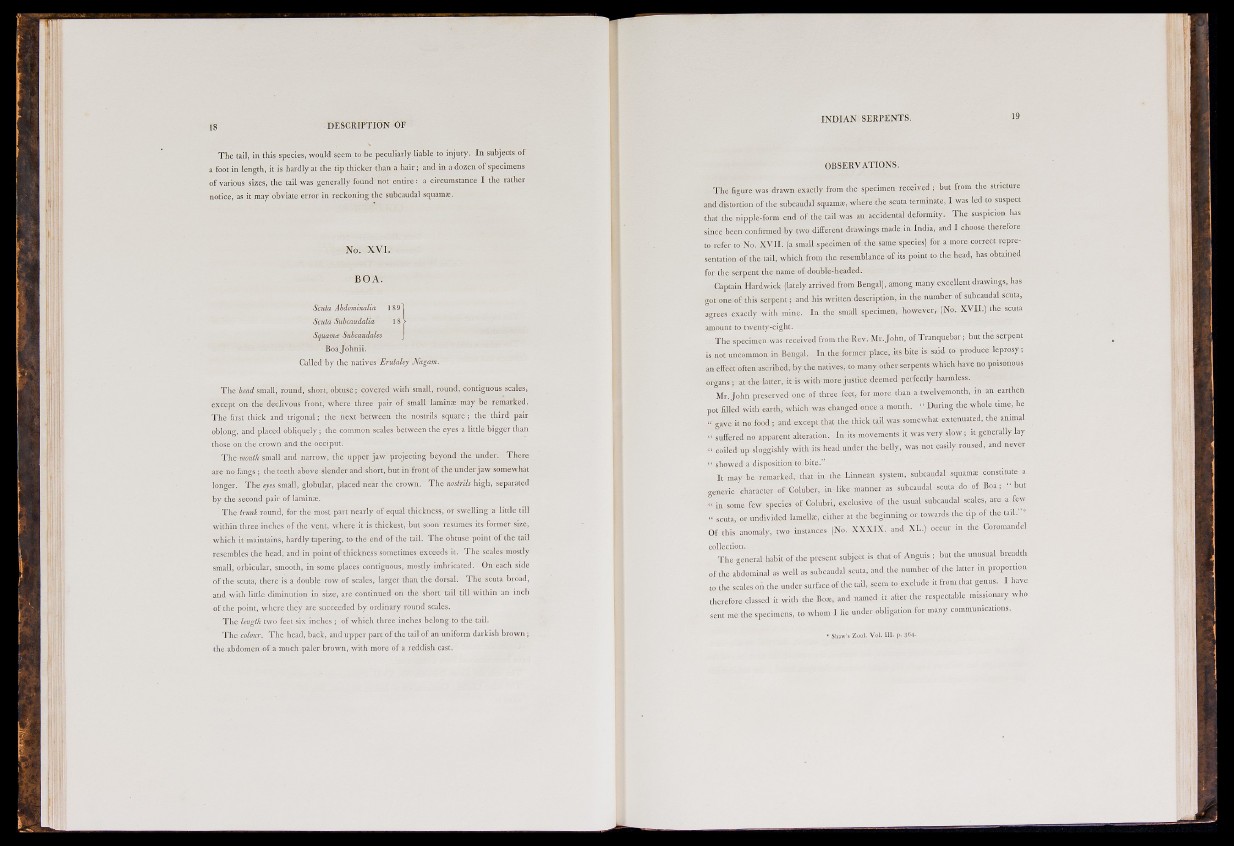
18 DESCRIPTION OF
The tail, in this species, would seem to be peculiarly liable to injury. In subjects of
a foot in length, it is hardly at the tip thicker than a hair ; and in a dozen of specimens
of various sizes, the tail was generally found not entire: a circumstance I the rather
notice, as it may obviate error in reckoning the subcaudal squamae.
No. XVI.
BOA.
Scnta Ahdominalia
Scuta Subcaiidalia
Squama Subcaudales
Boa Johni i .
Called by the natives Eriitaley Xagam.
The head small, round, short, obtuse; covered with small, round, contiguous scales,
except on the declivous front, where three pair of small laminas may be remarked.
The first thick and trigonal; the next between the nostrils square ; the third pair
oblong, and placed obliquely; the common scales between the eyes a little bigger than
those on the crown and the occiput.
The month small and narrow, the upper jaw projecting beyond the under. There
are no hmgs ; the teeth above slender and short, but in front of the under jaw somewhat
longer. The eyes small, globular, placed near the crown. The nostrils high, separated
by the second pair of lamina.
The trunk round, for the most part nearly of equal thickness, or swelling a little till
within three inches of the vent, where it is thickest, but soon resumes its former size,
which it maintains, hardly tapering, to the end of the tail. The obtuse point of the tail
resembles the head, and in point of thickness sometimes exceeds it. The scales mostly
small, orbicular, smooth, in some places contiguous, mostly imbricated. On each side
of the scuta, there is a double row of scales, larger than the dorsal. The scuta broad,
and with little diminution in size, are continued on the short tail till within an inch
of the point, where they are succeeded by ordinary round scales.
The length two feet six inches ; of which three inches belong to the tail.
The colour. The head, back, and upper part of the tail of an uniform darkish brown;
the abdomen of a much paler brown, with more of a reddish cast.
I N D I A N SERPENTS.
OBSERVATIONS.
The figure was drawn exactly from the specimen received ; but from the stricture
and distortion of the subcaudal squams;, where the scuta terminate, I was led to suspect
that the nipple-form end of the tail was an accidental deformity. The suspicion has
since been confirmed by two different drawings made in India, and I choose therefore
to refer to No. XVII. (a small specimen of the same species) for a more correct representation
of the tail, which from the resemblance of its point to the head, has obtained
for the serpent the name of double-headed.
Captain Hardwick (lately arrived from Bengal), among many excellent drawings, has
got one of this serpent; and his written description, in the number of subcaudal scuta,
agrees exactly with mine. In the small specimen, however, (No. XVII.) the scuta
amount to twenty-eight.
The specimen was received from the Rev. Mr. J o h n , of Tranquebar ; but the serpent
is not uncommon in Bengal. In the former place, its bite is said to produce leprosy;
an effect often ascribed, by the natives, to many other serpents which have no poisonous
organs ; at the latter, it is with more justice deemed perfectly harmless.
Mr. J o h n preserved one of three feet, for more than a twelvemonth, in an earthen
pot filled with earth, which was changed once a month. " During the whole time, he
" gave it no food ; and except that the thick tail was somewhat extenuated, the animal
suffered no apparent alteration. In its movements it was very slow ; it generally lay
- coiled up sluggishly with its head under the belly, was not easily roused, and never
" showed a disposition to bite."
It may be remarked, that in the Linnean system, subcaudal squamae constitute a
generic character of Coluber, in like manner as subcaudal scuta do of Boa; "but
" in some few species of Colubri, exclusive of the usual subcaudal scales, are a few
" scuta, or undivided lamells, either at the beginning or towards the tip of the tail."*
Of this' anomaly, two instances (No, XXXIX. and XL.) occur in the Coromandel
collection.
The general habit of the present subject is that of Anguis ; but the unusual breadth
of the abdominal as well as subcaudal scuta, and the number of the latter in proportion
to the scales on the under surface of the tail, seem to exclude it from that genus. I have
therefore classed it with the Bo.^, and named it after the respectable missionary who
sent mo the specimens, to whom I lie under obligation for many communications.
• Shaw's Zool. Vol. HI. p. 364.